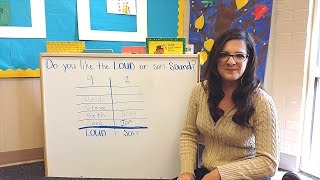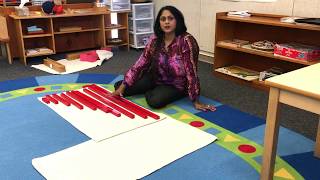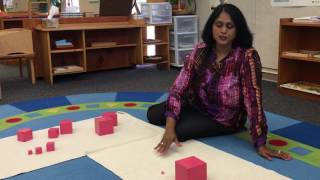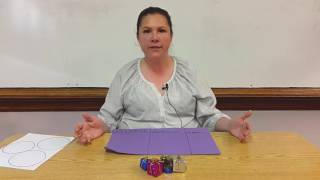Graphing With a Grid and Objects
Neva Thiessen | Early Childhood Educator | Wichita, Kansas
A lesson that teaches students how to sort and graph using objects. The students can sort the objects by different characteristics and then graph them on paper.
Read Transcript
Hi. Today, I’m going to talk about one way I teach graphing to my students. So, when I talk about graphing objects I talk to my kids about collecting data, because were usually, that’s what we say, we collect some data, we have all this information now. For example, all these presents that are on the table, and I want to know which one I have the most of. Which one I have the least of, maybe which two are the same or equal. So, in order to do that we need to organize it in a way that everybody can understand it. So, first skill they need to have before they graph is sorting. So, they understand that they may have sorted their presents into small, medium, and large sizes. So, these are sorted and then they’re going to organize their information in a way that everybody can understand. So, two things you can use. You can have a grid to help them when they’re placing their objects so that they place them equally and that they start at a certain place altogether, or you can just have a line on a piece of paper like this and they could build up from the bottom. So, what I would do is I, we would talk about this and usually a student will say, well you line them up, because that’s the most basic skill. So, we would talk about lining up our, all of our presents, and they would line them up. And, I’d say okay, so we’ve lined them all up, here it is. Now, if you’re trying to provoke some conversation you might say this, well now looking at it I would say that I, the most I have are, the largest number is my large. Right? My large presents and they’ll say no, no, no because, these are all squashed together, that’s usually what they say, and I’ll say well that’s what it looks like to me because this is longer. And so, you’re all, again kind of promoting some discussions about what they see and how they can make this more understandable for other people. So, they might say no you have to line them up the same. That’s usually what they’re going to say, and they’ll start, line them up. So, if I’ll put this one here, and this one goes next to it, and then the small one here, and then I’m going to put the large one here, and this medium, and then the small one here. See how they’re lined up? That’s what they’re going to be explaining to you. And so, they’ll go ahead and do this. Now, you don’t need any paper to do this activity as long as at least one of the kids mentions that they need to be spaced accordingly so that you can take a measurable count. Really, so they can do, you can do it this way, or you can say well now that we did, we lined it up here, and we sorted our data, and we kind of graft it. I’m going to show you on this grid. So, then you would have the kids place it on a grid. They can each get a set of whatever kind of manipulative you use, and then they would just kind of line up their objects into their grid. And then, I also explained that one object per square on the grid. Okay, you can’t double up. And so, what they would do is they would line up their objects according to how they were sorted, and then they would say well I have, the most on my graph is medium. I have one, two, three, four, five, six. I would ask for understanding, how do you know? They’re going to say, I know because I counted, and it’s taller. And I might ask, well which one has the least? And they may say, well the small and large are the same and they’re still less than the medium. So, this can involve a lot of discussion, and it’s really great to have them explain it to you in a complete sentence, and it’s a really fun activity for the kids. And again, you can graph anything you want. So, I hope you enjoyed this. Thanks.
Help teachers and children
worldwide by sharing how
you teach.
A global movement of people sharing knowledge and learning from each other, to better educate our children and create hope for the world.
A global movement of people sharing knowledge and learning from each other, to better educate our children and create hope for the world.






